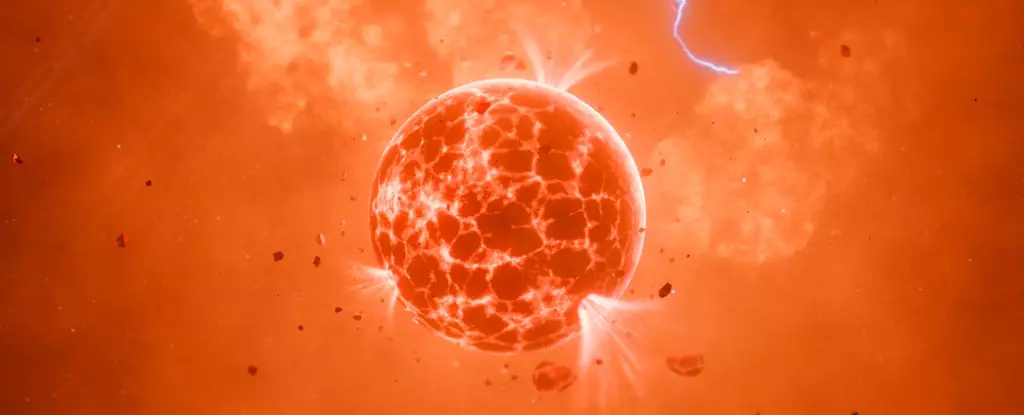Astronomy continually unveils mysteries that challenge past knowledge and assumptions about celestial bodies. One such breakthrough comes from findings surrounding a peculiar exoplanet known as WASP-49b, which is located approximately 635 light-years from Earth. Recent investigations have indicated that this exoplanet might be accompanied by a volcanic moon—an unprecedented finding that could reshape our understanding of exo-moon systems.
The potential volcanic activity on this moon is suggested by a substantial cloud of sodium that appears to be in orbit around WASP-49b. This revelation is particularly exciting because, as a gas giant, WASP-49b is not expected to harbor volcanic features, leading researchers to believe that the sodium cloud may be emanating from an orbiting moon. Apurva Oza, an astrophysicist at Caltech, has pointed out that the observed cloud is behaving in a manner inconsistent with what would be expected if it were part of the planet’s own atmosphere, steering thoughts towards the presence of a highly geologically active exomoon.
The Moon Paradigm Shift
Historically, our understanding of moons has been derived primarily from our own Solar System. The planets here have been accompanied by close to 300 moons, demonstrating that moons are common companions in planetary systems. However, despite the abundance of moons in our Solar System, concrete evidence of exomoons has remained elusive. The scarcity of findings in this realm highlights the challenges astronomers face—not only do they need to first confirm the existence of an exoplanet, but they should also scour the surrounding area for proof of lunar bodies, which are often faint and difficult to detect.
Given this context, the sodium cloud’s connection to a volcanic moon revolving around WASP-49b is groundbreaking. This detection is particularly noteworthy as it adds a new layer to our comprehension of celestial bodies outside our immediate planetary neighborhood.
Previous Research and Evidence
The narrative surrounding WASP-49b’s volcanic tendencies began with initial studies conducted in 2017, when astronomers first detected anomalous sodium levels associated with the gas giant. Researchers noted that the sodium cloud was positioned at elevations much higher than would typically be expected, suggesting something unique was occurring in this system.
In 2019, Oza and his colleagues advanced a compelling hypothesis; they posited that the sodium emanated not from the gas giant itself but from a lurking exomoon. By comparing the characteristics of WASP-49b with more understood systems, the team drew parallels to Jupiter and its moon Io, known for its volcanic activity spurred by gravitational interactions.
Building on these observations, the team employed meticulous data gathering over several nights using the European Southern Observatory’s Very Large Telescope. They analyzed whether this sodium cloud was a constant feature or merely temporary. The results revealed that the sodium’s appearance was highly irregular, further supporting the theory of an exomoon at work.
An intriguing aspect of the proposed volcanic moon is the mechanisms which could drive its geological activity. Unlike terrestrial planets, gas giants lack the necessary composition for volcanism themselves. Instead, the theory suggests that vigorous tidal forces, resulting from the moon’s close proximity to WASP-49b, could generate significant internal friction and heat. This phenomenon is similar to the gravitational interplay observed between Jupiter’s Galilean moons.
Moreover, the continuous loss of mass from volcanic eruptions could mean that this exomoon is on a decay trajectory, ultimately leading it to spiral into WASP-49b over time. This scenario, while devastating for the moon’s future, presents a fascinating opportunity to witness the life cycle and demise of a moon, offering insights into the dynamic interactions that shape planetary systems.
The discovery surrounding the potential volcanic exomoon of WASP-49b opens new doors for astronomical research. Questions abound regarding the formation and evolution of moons around gas giants—specifically, what consequences their geological activity might have on the atmospheres of host planets and the behavior of surrounding celestial bodies.
As detection methods improve and technology advances, astronomers are optimistic about uncovering more exomoons. The significance of findings like those surrounding WASP-49b highlights the intricate dance of celestial mechanics and the importance of addressing the vast unknowns that linger beyond our Solar System. This case reinforces the notion that the universe is capable of hosting far more complexity than previously imagined, reminding us that each discovery propels our understanding forward.
In sum, the potential existence of a volcanic exomoon around WASP-49b not only enriches our celestial narratives but also encourages a reexamination of what we deem possible within the cosmic tapestry of existence. As research in this field progresses, we stand to learn an incredible amount about the intricate interplay between moons, planets, and the myriad forces that shape our universe.


Leave a Reply